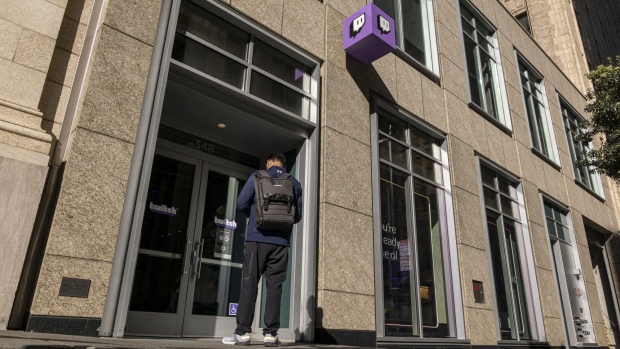Feb 15, 2023
Amazon’s Twitch Channel Is Exaggerating Its Popularity
, Bloomberg News

(Bloomberg) -- When Amazon.com Inc. launched the Crown Channel on its livestreaming platform Twitch in 2019, the e-commerce giant was looking to flex its entertainment chops in the buzzy world of video games—an arena the company had been trying to break into for years. Resembling a traditional television network, Crown offers a range of ad-supported original programming, including “Screen Invaders!,” a show about mobile gaming.
Amazon says Crown is among Twitch’s top 10 entertainment channels, luring tens of thousands of viewers—a feat typically equaled only by Twitch’s top personalities—and is attracting such big-name advertisers as chipmaker Intel Corp. and insurer Progressive Corp. But a Bloomberg analysis of Crown audience metrics shows the channel isn’t as popular as Amazon says it is. That has potential implications for brands, which according to internal documents, may have paid anywhere from $150,000 to $500,000-plus to promote themselves on the channel.
A pitch deck for advertisers from January 2022 said the Crown channel then reached 43 million viewers and had a “highly engaged audience.” But most of the viewers Crown cites are what the advertising industry calls “junk views,” people who aren’t actively watching the programming. Although Crown appears to draw in thousands of viewers each livestream, comparatively few people follow the channel or participate in its chats—suggesting they aren’t engaging with the content.
Amazon sometimes pays Twitch tens of thousands of dollars to promote Crown programs on the site’s home page, where they end up in a digital carousel that viewers scroll through, typically zipping past shows until they find something they want to watch.
“Someone who lands on Twitch’s front page and then navigates off to watch another streamer is not a highly engaged viewer,” said Marcus Graham, a vice president of community development at game developer Fortis Games who previously worked at Twitch for 10 years. He compares it to “channel surfing.” “The front page is what I call ‘hollow traffic.’”
Audience inflation has been a long-standing issue for video and social-media sites. In 2018, a group of advertisers successfully sued Facebook, owned by Meta Platforms Inc., claiming it misled advertisers for years about the average time users spent viewing online video clips, which generated significant advertising revenue. The plaintiffs settled for $40 million. Many platforms have developed technology to root out audience inflation. But Frank Fields, an associate talent director at RTS, which works with brands and content creators, said many gaming sites like Twitch still make it hard to distinguish between an engaged viewer and someone who has stepped away from their keyboard.
An Amazon spokesperson disputed the idea that Crown’s audience metrics are based on junk views and said the company is “very transparent with our partners and advertisers, which has led to many repeat events and collaborations.” He added that in the final three months of 2022, the channel averaged 6.7 minutes watched per viewer. To calculate the metric, he said, the company divided the total minutes that content was watched on Crown during that period by “unique viewers.”
“Crown is a nascent and growing entertainment platform, and we stand behind the content we produce,” the spokesperson said.
When Amazon bought Twitch in 2014 for almost $1 billion, the company hoped to leverage the budding livestreaming site as a showcase for its gaming ambitions, including titles developed by Amazon’s own studio. Today Twitch is the largest livestreaming platform in the world, but Amazon is still struggling to make hit games, producing just one—called New World—that was initially popular before losing momentum.
Crown is an effort to bring together the company’s Prime Video, Prime Gaming and Twitch audiences in one place. “The Crown Channel is the culmination of Amazon finally saying, ‘Through Prime Gaming and Amazon Prime, this is a natural addition to our content offering,’” Graham said. “But more importantly, [it’s] another medium for advertising.”
Amazon has spent millions on talent, marketing and production, according to the internal documents. The talent and production budget for a December event called RE//LOAD, streamed in partnership with Riot Games, was $2.2 million dollars, according to the documents. The program included Twitch stars such as Ali “Myth” Kabbani, who boasts about 7 million followers on the platform.
But Twitch has struggled for years to create compelling TV-like programming. The site shuttered its Twitch Studios content arm in 2018, laying off several employees. While Amazon’s Crown Channel features solid production values and intricate sets, it lacks a consistent cast of Twitch personalities who attract repeat viewers.
The “Screen Invaders” show that aired in late December—a one-off event designed to highlight Amazon Prime Gaming perks for various mobile titles—featured two teams of three (all in matching windbreakers) competing in the mobile game Candy Crush Saga. The game is not popular on Twitch, where just two people are watching streamers play it at any given time. Yet somehow, Crown's Candy Crush episode registered more than 30,000 viewers.
In late October, when Crown registered an average of 19,000 live viewers, only 22 of them sent messages in the channel’s Twitch chat each minute, according to internal documents. That equals about 6% of the messaging traffic in other channels with similar viewership, according to a Bloomberg analysis. In another sign of a disengaged audience, an average of 14,000 viewers tuned into Crown’s live shows in December, but the channel lost dozens of followers per hour during most livestreams, according to TwitchTracker. By contrast, eight other Twitch streams with similar viewership gained an average of 514 followers per hour.
“Metrics in this industry can often be confusing if taken at face value,” said Fields, the associate talent director. “The gaming industry needs better expectations and definitions for metrics.”
©2023 Bloomberg L.P.





